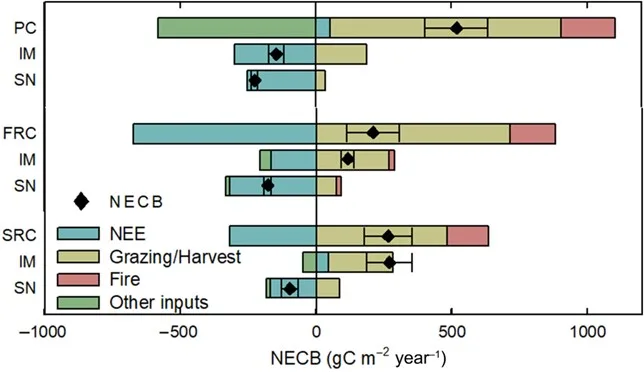Impact of Sugarcane Cultivation on C Cycling in Southeastern United States Following Conversion from Grazed Pastures
Themes: Sustainability
Keywords: Carbon, Field Data, Soil
Citation
Gomez-Casanovas, N., Blanc-Betes, E., Bernacchi, C.J., Boughton, E.H., Yang, W., Moore, C., Pederson, T.L., Saha, A., DeLucia, E.H. Aug. 28, 2024. “Impact of Sugarcane Cultivation on C Cycling in Southeastern United States Following Conversion From Grazed Pastures.”. FigShare. DOI: 10.6084/m9.figshare.26863441.v1
Overview

The expansion of sugarcane, a tropical high-yielding feedstock, will likely reshape the Southeastern United States (SE US) bioenergy landscape. However, the sustainability of sugarcane, particularly as it displaces grazed pastures, is highly uncertain. Here, we investigated how pasture conversion to sugarcane in subtropical Florida impacts net ecosystem CO2 exchange (NEE) and net ecosystem carbon (C) balance (NECB). Measurements were made over three full growth cycles (> 3 years) in sugarcane—plant cane, PC; first ratoon cane, FRC; second ratoon cane, SRC—and in improved (IM) and semi-native (SN) pastures, which make up ca. 37% of agricultural land in the region. Immediately following conversion, PC was a stronger net source of CO2 than pastures, indicating the importance of CO2 losses related to land disturbance. Sugarcane, however, shifted to a strong net sink of CO2 after first regrowth, and overall sugarcane was a stronger net CO2 sink than pastures. Both stand age and low water availability during cane emergence and tillering substantially decreased its potential gross CO2 uptake. Accounting for all C gains and removals (i.e., NECB), greater frequency of burn events and repeated harvest increased removals and overall made sugarcane a stronger C source relative to pastures despite substantial C inputs from the previous land use and a stronger CO2 sink strength. Time since conversion substantially reduced C losses from sugarcane, and the NECB of SRC was similar to that of IM pasture but lower than that of SN pasture, indicating a rapid shift in the NECB of cane. We conclude that the C-balance implications following conversion will depend on the proportion of IM versus SN pastures converted to sugarcane. Furthermore, our findings suggest that no-burn harvest management strategies will be critical to the development of a sustainable bioenergy landscape in SE US.
Data
Data includes:
- CO2 fluxes (NEE, GPP)
- Biomet variables (meteorological, soil)